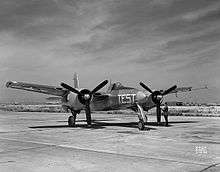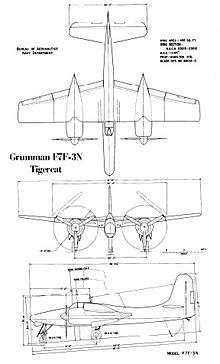Grumman F7F Tigercat
| F7F Tigercat | |
|---|---|
 | |
| An F7F-3P preserved in United States Marine Corps markings in flight | |
| Role | heavy fighter |
| National origin | United States |
| Manufacturer | Grumman |
| First flight | 2 November 1943 |
| Introduction | 1944 |
| Retired | 1954 |
| Primary users | United States Navy United States Marine Corps |
| Produced | 1943–1946 |
| Number built | 364 |
| Developed into | Grumman XTSF |
The Grumman F7F Tigercat is a heavy fighter aircraft that served with the United States Navy (USN) and United States Marine Corps (USMC) from late in World War II until 1954. It was the first twin-engined fighter to be deployed by the USN. While the Tigercat was delivered too late to see combat in World War II, it saw action as a night fighter and attack aircraft during the Korean War.
Designed initially for service on Midway-class aircraft carriers, early production F7Fs were land-based variants. The type was too large to operate from older and smaller carriers, and only a late variant (F7F-4N) was certified for carrier service.
Design and development
Based on the earlier Grumman XP-50 that was eventually canceled, the company developed the XP-65 (Model 51) further for a future "convoy fighter" concept. In 1943, work on the XP-65 was terminated in favor of the design that would eventually become the F7F.[1] The contract for the prototype XF7F-1 was signed on 30 June 1941. Grumman's aim was to produce a fighter that outperformed and outgunned all existing fighter aircraft, and that had an auxiliary ground attack capability.[2] Armament was heavy: four 20 mm cannon and four 0.50 in (12.7 mm) machine guns, as well as underwing and under-fuselage hardpoints for bombs and torpedoes. Performance met expectations too; the F7F Tigercat was one of the highest performance piston-engined fighters, with a top speed well in excess of the US Navy's single-engined aircraft—71 mph faster than a Grumman F6F Hellcat at sea level.[3] CAPT Fred M. Trapnell, one of the Navy's premier test pilots, opined that: "It's the best damn fighter I've ever flown."[4] The Grumman F7F was originally named the "Tomcat" but this name was rejected as it was considered too suggestive, at the time.[5] The name would much later be used for the Grumman F-14.

All this was bought at the cost of heavy weight and a high landing speed, but what caused the aircraft to fail carrier suitability trials was poor directional stability with only one engine operational, as well as problems with the arrestor hook design.[6] The initial production series was therefore used only from land bases by the USMC, as night fighters with APS-6 radar.[7] At first, they were single-seat F7F-1N aircraft, but after the 34th production aircraft, a second seat for a radar operator was added; these aircraft were designated F7F-2N.
The next version produced, the F7F-3, was modified to correct the issues that caused the aircraft to fail carrier acceptance and this version was again trialled on the USS Shangri-La. A wing failure on a heavy landing caused the failure of this carrier qualification too. F7F-3 aircraft were produced in day fighter, night fighter and photo-reconnaissance versions.[8]
A final version, the F7F-4N, was extensively rebuilt for additional strength and stability, and did pass carrier qualification, but only 12 were built.[8]
Operational history
Marine Corps night fighter squadron VMF(N)-513 flying F7F-3N Tigercats saw action in the early stages of the Korean War, flying night interdiction and fighter missions and shooting down two Polikarpov Po-2 biplanes.[9] This was the only combat use of the aircraft.
Most F7F-2Ns were modified to control drones for combat training, and these gained bubble canopies over the rear cockpit for the drone controller. An F7F-2D used for pilot transitioning also had a rear sliding, bubble canopy.[10]
In 1945, two Tigercats, serialled TT346 and TT349, were evaluated, but rejected, by the British Royal Navy, who preferred a navalized version of the de Havilland Hornet.[11]
Variants


-531.jpeg)
- XP-65
- Proposed U.S. Army Air Forces pursuit fighter.
- XF7F-1
- Prototype aircraft, two built.
- F7F-1 Tigercat
- Twin-engine fighter-bomber aircraft, powered by two Pratt & Whitney R-2800-22W radial piston engines. First production version, 34 built.
- F7F-1N Tigercat
- Single-seat night fighter aircraft, fitted with an APS-6 radar.
- XF7F-2N
- Night-fighter prototype, one built.
- F7F-2N Tigercat
- Two-seat night fighter, 65 built.
- F7F-2D
- Small numbers of F7F-2Ns converted into drone control aircraft. The aircraft were fitted with an F8F Bearcat windshield behind the cockpit.
- F7F-3 Tigercat
- Single-seat fighter-bomber aircraft, powered by two Pratt & Whitney R-2800-34W radial piston engines and featuring an enlarged tailfin for improved stability at high altitudes, 189 built.
- F7F-3N Tigercat
- Two-seat night fighter aircraft, 60 built.
- F7F-3E Tigercat
- Small numbers of F7F-3s were converted into electronic warfare aircraft.
- F7F-3P Tigercat
- Small numbers of F7F-3s were converted into photo-reconnaissance aircraft.
- F7F-4N Tigercat
- Two-seat night-fighter aircraft, fitted with an arrestor hook and other naval equipment, 13 built.
Operators
Survivors


Beginning in 1949, F7Fs were flown to the then-US Navy storage facility at Naval Air Station Litchfield Park, Arizona.[12] Although the vast majority of the airframes were eventually scrapped, a number of examples were purchased as surplus. The surviving Tigercats were primarily used as water bombers to fight forest fires in the 1960s and 1970s and Sis-Q Flying Services of Santa Rosa, California operated an F7F-3N tanker in this role until retirement in the late 1980s.


- Airworthy
- F7F-3
- 80374: Tigercat N7629C LCC in Wilmington, Delaware.[13]
- 80375: Tigercat N379AK LLC in Bellevue, Washington.[14]
- 80390: Lewis Air Legends in San Antonio, Texas.[15][16]
- 80411: Palm Springs Air Museum in Palm Springs, California.[17][18]
- 80425: Avstar Inc. in Seattle, Washington.[19]
- 80483: Historic Flight Foundation in Mukilteo, Washington.[20][21]
- 80503: Lewis Air Legends in San Antonio, Texas.[22][23]
- 80532: Lawrence Classics LLC in Bentonville, Arkansas.[24]
- On display
- F7F-3
- 80373: National Naval Aviation Museum in NAS Pensacola, Florida.[25]
- 80382: Planes of Fame Museum in Chino, California.[26]
- 80410: Pima Air & Space Museum, adjacent to Davis-Monthan AFB, in Tucson, Arizona.[27]
- Under restoration
- F7F-3
- 80404: in storage at the Fantasy of Flight in Polk City, Florida.[28]
Specifications (F7F-4N Tigercat)

Data from Jane's Fighting Aircraft of World War II[29]
General characteristics
- Crew: 2 (pilot, radar operator)
- Length: 45 ft 4 in (13.8 m)
- Wingspan: 51 ft 6 in (15.7 m)
- Height: 16 ft 7 in (5.1 m)
- Wing area: 455 ft² (42.3 m²)
- Empty weight: 16,270 lb (7,380 kg)
- Max. takeoff weight: 25,720 lb (11,670 kg)
- Powerplant: 2 × Pratt & Whitney R-2800-34W Double Wasp radial engines, 2,100 hp (1,566 kW) each
Performance
- Maximum speed: 460 mph (400 knots, 740 km/h)
- Range: 1,200 mi (1,000 nmi, 1,900 km)
- Service ceiling: 40,400 ft (12,300 m)
- Rate of climb: 4,530 ft/min (23 m/s)
Armament
- Guns:
- 4 × 20 mm (0.79 in) AN/M3 cannon
- 4 × 0.50 in (12.7 mm) M2 Browning machine gun
- Bombs:
Avionics
- AN/APS-19 radar
See also
- Related development
- Aircraft of comparable role, configuration and era
- de Havilland Hornet
- FMA I.Ae. 30 Ñancú
- Kawasaki Ki-102
- Focke-Wulf Ta 154
- Rikugun Ki-93
- Northrop P-61 Black Widow
- Mitsubishi Ki-83
- Related lists
- List of aircraft of World War II
- List of military aircraft of the United States
- List of military aircraft of the United States (naval)
References
- Notes
- ↑ Dorr and Donald 1990, p. 119.
- ↑ Thruelsen 1976, p. 204.
- ↑ Meyer 2002, p. 51.
- ↑ Meyer 2002, p. 54.
- ↑ Meyer 2002, p. 50.
- ↑ Meyer 2002, p. 55.
- ↑ Thruelsen 1976, p. 205.
- 1 2 Taylor 1969, p. 504.
- ↑ Grossnick and Armstrong 1997
- ↑ Gault 1973, p. 25.
- ↑ Zuk 2004, p. 129.
- ↑ Legg 1991, p. 26.
- ↑ "FAA Registry: N7629C". FAA.gov. Retrieved: 16 May 2011.
- ↑ "FAA Registry: N379AK". FAA.gov. Retrieved: 14 July 2014.
- ↑ "FAA Registry: N700F". FAA.gov. Retrieved: 16 May 2011.
- ↑ "Grumman F7F Tigercat/Bu. 80390". Lewis Air Legends. Retrieved: 23 February 2014.
- ↑ "FAA Registry: N207F". FAA.gov. Retrieved: 16 May 2011.
- ↑ "Grumman F7F Tigercat/Bu. 80411". Palm Springs Air Museum. Retrieved: 23 February 2014.
- ↑ "FAA Registry: N909TC". FAA.gov. Retrieved: 16 May 2011.
- ↑ "FAA Registry: N6178C". FAA.gov. Retrieved: 16 May 2011.
- ↑ "Grumman F7F Tigercat/Bu. 80483". Historic Flight Foundation. Retrieved: 23 February 2014.
- ↑ "FAA Registry: N747MX". FAA.gov. Retrieved: 05 September 2013.
- ↑ "Grumman F7F Tigercat/Bu. 80503". Lewis Air Legends. Retrieved: 23 February 2014.
- ↑ "FAA Registry: N7195C". FAA.gov. Retrieved: 16 May 2011.
- ↑ "Grumman F7F Tigercat/Bu. 80373". National Naval Aviation Museum. Retrieved: 11 April 2012.
- ↑ "Grumman F7F Tigercat/Bu. 80382". Planes of Fame Museum. Retrieved: 13 December 2010. This aircraft was previously described as airworthy. As of this date (18 April 2017) it clearly is not. Stored at Planes of Fame, Chico, CA.
- ↑ "Grumman F7F Tigercat/Bu. 80410". Pima Air & Space Museum. Retrieved: 11 April 2012.
- ↑ "FAA Registry: N7626C". FAA.gov. Retrieved: 16 May 2011.
- ↑ Bridgman 1946, p. 233.
- Bibliography
- Bridgman, Leonard (ed.). “The Grumman Tigercat.” Jane’s Fighting Aircraft of World War II. London: Studio, 1946. ISBN 1-85170-493-0.
- Carlson, Ted. "Semper Fi Tigercat". Flight Journal, Volume 13, Issue 2, April 2008.
- Carr, Orrin I. "Fire 'Cat!" Air Classics, Vol. 12, No. 9, Sept. 1976. Canoga Park, CA: Challenge Publications, pp. 38–47.
- Dorr, Robert F. and David Donald. Fighters of the United States Air Force. London: Temple, 1990. ISBN 0-600-55094-X.
- Gault, Owen. "Grumman's Tiger Twins: The Skyrocket & Tigercat". Air Classics, Vol. 9, No. 8, Aug. 1973. Canoga Park, CA: Challenge Publications, pp. 22–27.
- Green, William. "Grumman F7F-1 – F7F-3 Tigercat". War Planes of the Second World War, Volume Four: Fighters London: Macdonald & Co.(Publishers) Ltd., 1961, pp. 106–108. ISBN 0-356-01448-7.
- Green, William and Gordon Swanborough. "Grumman F7F Tigercat". WW2 Fact Files: US Navy and Marine Corps Fighters. London: Macdonald and Jane's Publishers Ltd., 1976, pp. 57–61. ISBN 0-356-08222-9.
- Grossnick, Roy A. and William J. Armstrong. United States Naval Aviation: 1910–1995. Annapolis, MA: Naval Historical Center, 1997. ISBN 0-16-049124-X.
- Legg, David. "Tigercat on camera". Aircraft Illustrated, Volume 24, no. 1, January 1991.
- Meyer, Corwin ("Corky") H. "F7F Tigercat: The Untold Story". Flight Journal, August 2002. Ridgefield, CT: AirAge Publications. pp. 48–56, 58.
- Morgan, Eric B. "Grumman F7F Tigercat F.7/30". Twentyfirst Profile, Volume 1, No. 11. New Milton, Hants, UK: 21st Profile Ltd. ISSN 0961-8120.
- Morgan, Eric B. "The Grumman Twins". Twentyfirst Profile, Volume 2, No. 15. New Milton, Hants, UK: 21st Profile Ltd. ISSN 0961-8120.
- O'Leary, Michael. "Tigercat Restoration". Air Classics, Vol. 38, No. 11, Nov. 2002. Canoga Park, CA: Challenge Publications.
- O'Leary, Michael. United States Naval Fighters of World War II in Action. Poole, Dorset, UK: Blandford Press, 1980. ISBN 0-7137-0956-1.
- Taylor, John W.R. "Grumman F7F Tigercat". Combat Aircraft of the World from 1909 to the Present. New York: G.P. Putnam's Sons, 1969. ISBN 0-425-03633-2.
- Thruelsen, Richard. The Grumman Story. New York: Praeger Publishers, Inc., 1976. ISBN 0-275-54260-2.
- Zuk, Bill. Janusz Zurakowski: Legends in the Sky. St. Catharine's, Ontario: Vanwell, 2004. ISBN 1-55125-083-7.
External links
| Wikimedia Commons has media related to Grumman F7F Tigercat. |
- Manual: (1949) AN 01-85FA-1 Pilot's Handbook for Navy Model F7F-1N, F7F-2N, F7F-3, F7F-3N, F7F-4N Airplanes
- Naval Aviation Museum: F7F History & Pictures
- F7F Tigercat "Big Bossman" air Racer
- F7F Tigercat Flight Demonstration by Clay Lacy